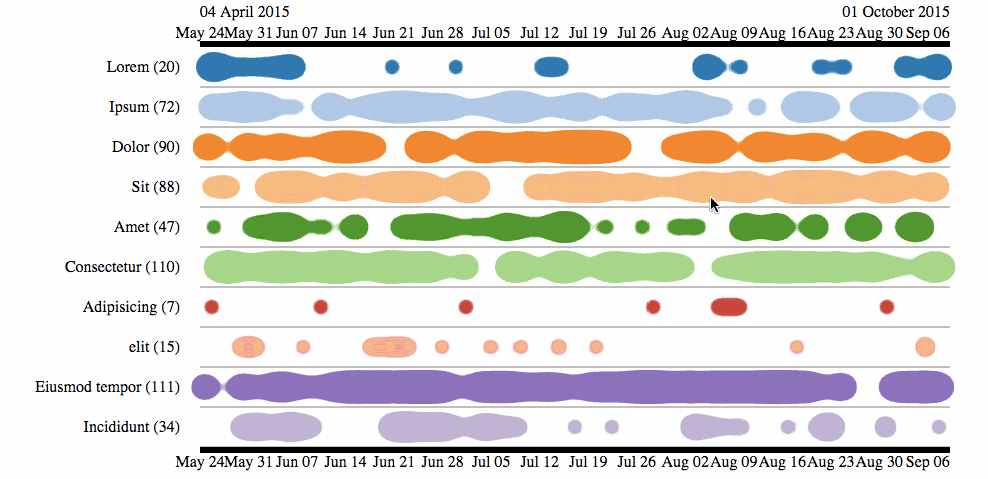
Security News
Fluent Assertions Faces Backlash After Abandoning Open Source Licensing
Fluent Assertions is facing backlash after dropping the Apache license for a commercial model, leaving users blindsided and questioning contributor rights.
event-drops
Advanced tools
A time based / event series interactive visualization using d3.js. Use drag and zoom to navigate in time.
A time based / event series interactive visualization using d3.js. Use drag and zoom to navigate in time. See the demo

You can use npm to install event-drops
npm install event-drops --save
For Bower users, even if Bower is not officially supported, you can still use GitHub URL such as:
{
"dependencies": {
"eventDrops": "marmelab/EventDrops#0.1.2"
}
}
Include the src/eventDrops.js script in your page after d3:
<script src="path/to/d3.js"></script>
<script src="src/eventDrops.js"></script>
Tip: You can also use RequireJs, see example/amd for an implementation.
In the HTML source, create a new EventDrops chart, bind data to a DOM element, then call the chart on the element.
var eventDropsChart = d3.chart.eventDrops();
d3.select('#chart_placeholder')
.datum(data)
.call(eventDropsChart);
The data can be an array of named time series. For instance:
var data = [
{ name: "http requests", data: [new Date('2014/09/15 13:24:54'), new Date('2014/09/15 13:25:03'), new Date('2014/09/15 13:25:05'), ...] },
{ name: "SQL queries", data: [new Date('2014/09/15 13:24:57'), new Date('2014/09/15 13:25:04'), new Date('2014/09/15 13:25:04'), ...] },
{ name: "cache invalidations", data: [new Date('2014/09/15 13:25:12'), ...] }
];
You can also generate a chart from any type of data array but this requires us to supply a function that will return a date from each data point. The complete data object will be available during the eventColor and eventClick callbacks for example. An example data set:
var data = [
{ name: "http requests", data: [{date: new Date('2014/09/15 13:24:54'), foo: 'bar1'}, {date: new Date('2014/09/15 13:25:03'), foo: 'bar2'}, {date: new Date('2014/09/15 13:25:05'), foo: 'bar1'}, ...] },
{ name: "SQL queries", data: [{date: new Date('2014/09/15 13:24:57'), foo: 'bar4'}, {date: new Date('2014/09/15 13:25:04'), foo: 'bar6'}, {date: new Date('2014/09/15 13:25:04'), foo: 'bar2'}, ...] }
];
And the corresponding "date" function that returns a date for each data point.
var eventDropsChart = d3.chart.eventDrops();
d3.select('#chart_placeholder')
.datum(data)
.date(function(d){
return d.date;
}),
.call(eventDropsChart);
EventDrops follows the d3.js reusable charts pattern to let you customize the chart at will:
var eventDropsChart = d3.chart.eventDrops()
.width(1200)
.hasTopAxis(false);
Configurable values:
start: start date of the scale. Defaults to new Date(0).end: end date of the scale. Defaults to new Date()margin: margins of the graph in pixels. Defaults to { top: 60, left: 200, bottom: 40, right: 50 }locale: locale used for the X axis labels. See d3.locale for the expected format. Defaults to null (i.e. d3 default locale).labelsWidth: width of the labels. Defaults to 210.labelsRightMargin: margin between labels and drops lines. Defaults to 10.axisFormat: function receiving the d3 axis object, to customize tick number and size.tickFormat: tickFormat for the X axis. See d3.timeFormat.multi() for expected format.mouseover: function to be called when hovering an event in the chart. Receives the DOM element hovered (uses event delegation). Default: () => {}.zoomend: function to be called when done zooming on the chart. Receives the d3 scale at the end of the zoom. Default: () => {}.click: function to be called on click event of data-point (circle). Receives the DOM element hovered (uses event delegation). Default: () => {}.hasDelimiter: whether to draw time boundaries on top of the chart. Defaults to true.hasTopAxis: whether the chart has a top X axis. Accepts both a boolean or a function receiving the data of the graph that returns a boolean.hasBottomAxis: same as topAxis but for the bottom X axiseventLineColor: The color of the event line. Accepts a color (color name or #ffffff notation), or a function receiving the eventData and returning a color. Defaults to 'black'.eventColor: The color of the event. Accepts a color (color name or #ffffff notation), or a function receiving the eventData and returning a color. Defaults to null. EventLineColor will be ignored if this is used.minScale: The minimum scaling (zoom out), default to 0.maxScale: The maximum scaling (zoom in), default to Infinity.mouseout: event handler to execute when mouse leave a drop. Default: () => {}.zoomable: true by default. Enable zoom-in/zoom-out and dragging handlers.date: function that returns the date from each data point when passing objects. Defaults to d=>d.You can style all elements of the chart in CSS. Check the source to see the available selectors.
First, install the dependencies:
make install
For development purpose, you can use the following command:
make run
It serves the demo at http://localhost:8080. It also watches source files and live reloads your browser as soon as a change is detected.
When your changes are done, ensure that all tests pass with:
make test
Finally, if everything is fine, you can rebuild the library using:
make build
However, for better Pull Request reviewing, please do not commit the build files in the same PR. You can then rebuild it once merged.
EventDrops is released under the MIT License, courtesy of marmelab and Canal Plus.
FAQs
A time based / event series interactive visualization using d3.js. Use drag and zoom to navigate in time.
The npm package event-drops receives a total of 227 weekly downloads. As such, event-drops popularity was classified as not popular.
We found that event-drops demonstrated a not healthy version release cadence and project activity because the last version was released a year ago. It has 4 open source maintainers collaborating on the project.
Did you know?

Socket for GitHub automatically highlights issues in each pull request and monitors the health of all your open source dependencies. Discover the contents of your packages and block harmful activity before you install or update your dependencies.

Security News
Fluent Assertions is facing backlash after dropping the Apache license for a commercial model, leaving users blindsided and questioning contributor rights.

Research
Security News
Socket researchers uncover the risks of a malicious Python package targeting Discord developers.

Security News
The UK is proposing a bold ban on ransomware payments by public entities to disrupt cybercrime, protect critical services, and lead global cybersecurity efforts.